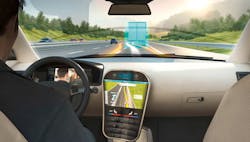In the preface to singing her rendition of the song “Proud Mary,” Tina Turner offers the following narrative:
You know, every now and then
I think you might like to hear something from us
Nice and easy
But there's just one thing
You see we never, ever do nothing
Nice and easy
We always do it nice and rough.
I was thinking about Ms. Turner’s characterization of her singing style when contemplating this week’s headlines about autonomous vehicles. Yes, there was a nice and easy part: the U.S. and Canada co-operating on a cross-border test of two self-driving vehicles, while 6,600 miles away from Detroit in Seoul the government gave the thumbs up to SK Telecom to test its autonomous cars on public roads.
There was a rough part this week, too: The government of India has declared it will ban self-driving cars.
We’ll look at both easy and rough. First, as they say, the good news.
In the U.S. automotive suppliers Continental and Magna, acting in conjunction with the Michigan Department of Transportation (MDOT) and the Ontario Ministry of Transportation (MTO), are conducting the first cross-border test of autonomous vehicles. Two self-driving vehicles will travel more than 300 miles, crossing into Windsor, Ontario before going north to Sarnia, Ontario and then return back into Michigan, arriving in Traverse City. These will be Level 3 tests; Level 3 autonomous driving still requires a driver be at the wheel of the vehicle, ready to take control at a moment's notice.
Using Continental’s Cruising Chauffeur function, the vehicles will be able to take over driving tasks on various roadways in accordance with traffic regulations. Once Cruising Chauffeur is activated, data analyzed in a central control unit called Assisted & Automated Driving Control Unit (ADCU) is used to generate a 360-deg. model of the vehicle’s surroundings. In combination with a high-resolution map, the system recognizes all moving and static objects, as well as the layout of the roadway ahead. The cross-border drive is designed to demonstrate how the vehicles’ multiple camera, radar and LiDAR sensors will interact while being driven underwater through the concrete Detroit-Windsor Tunnel and across the steel Blue Water Bridge.
- Continental’s Cruising Chauffer is capable of automated driving (SAE Level 3) in highway/freeway environments excluding entry ramps and exits, but including handling of traffic jams and stop-and-go traffic.
Both Michigan and Ontario have taken steps to ensure the region remains competitive as the automotive landscape evolves. In 2016, Gov. Rick Snyder signed a package of bills enabling automated vehicles to operate on roads across the state. That same year, Ontario became the first province to set a regulatory framework to permit testing of automated vehicles, making it the only province to have an automated vehicle pilot program in Canada.
Meanwhile in Seoul, SK Telecom (SKT) become the first South Korean mobile network provider to obtain permission from the country’s Ministry of Land, Infrastructure, and Transport (MOLIT) to temporarily drive its self-driving cars on actual roads.
In receiving this permission, SKT had to satisfy such requirements as adhering to a maximum speed limit, providing automatic detection of breakdowns, and converting to manual driving during an emergency.
To improve autonomous driving safety SKT, in partnership with Seoul National University and the US chipmaker Nvidia, will modify a Hyundai Genesis G80 adding radar, LIDAR, cameras for detecting surrounding cars and objects, 3D-HD maps, V2X (Vehicle to Everything Communication), and AI (Artificial Intelligence) software. The G80 also will be equipped with Advanced Driver Assistant Systems (ADAS) that detect hazards such as lane departure and potential collisions with pedestrians.
SK Telecom’s 3D-HD map shows geographic feature around roads, signals, and traffic signs with resolution said to be better than 25cm. V2X, which is usually based on LTE cellular service here is applied via a 5G network (SKT is, after all, a telecom company) to trim reaction speed to under 0.001 sec. 5G V2X will send and receive traffic information to other cars, control centers, and other infrastructure (e.g., traffic lights) in real-time.
The first public use of autonomous vehicles in Korea is widely expected to be 5G-based self-driving shuttle buses provided to visitors to the 2018 Pyeongchang Winter Olympics next February.
India Puts Up a Stop Sign
Here’s the rough part: A government edict in India last week threatened to make autonomous cars illegal in the world’s second most populous country. Here’s what Nitin Gadkari, India’s transport minister, told the Hindustan Times at a press conference: “We won’t allow driverless cars in India. I am very clear on this. We won’t allow any technology that takes away jobs. In a country where you have unemployment, you can’t have a technology that ends up taking people’s jobs.”
India seems to be taking a hard line on robotics and automation in general, believing that these technologies will be causing job losses on a large scale across a wide range of industries, including transport where truck, bus, and taxi drivers could lose their jobs if autonomous driving vehicles are permitted. The government is investing in some 100 driver training centers across India to help new drivers meet the demand for more trucks on Indian roads.
It is uncertain what if anything the Indian government plans to do about Tata Elxsi. The Bangalore company, part of the country’s biggest automaker, Tata Group, a Tier 1 automotive supplier, has developed and is licensing a software platform for driverless car R&D. Called Autonmai it is an interface between cameras, radar, and LIDAR using AI and machine learning algorithms to solve complex self-driving issues. Autonomai allows rapid region specific adaptation through its pre-integrated validation datasets and AI and deep learning capabilities. The company claims its software has been licensed to one of the top five carmakers globally (which it does not identify).
To us, the Indian government’s actions appear very short-sighted, particularly in a world where IHS Automotive predicts 21 million self-driving cars will be on public roads by 2035.
What do you think?

